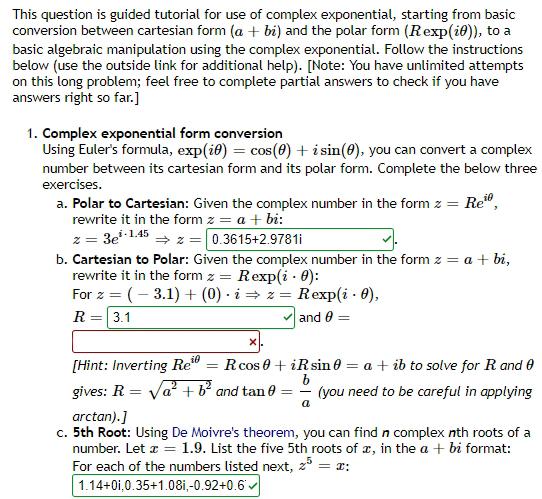Home /
Expert Answers /
Advanced Math /
this-question-is-guided-tutorial-for-use-of-complex-exponential-starting-from-basic-conversion-be-pa781
(Solved): This question is guided tutorial for use of complex exponential, starting from basic conversion be ...
This question is guided tutorial for use of complex exponential, starting from basic conversion between cartesian form \( (a+b i) \) and the polar form \( (R \exp (i \theta)) \), to a basic algebraic manipulation using the complex exponential. Follow the instructions below (use the outside link for additional help). [Note: You have unlimited attempts on this long problem; feel free to complete partial answers to check if you have answers right so far.] 1. Complex exponential form conversion Using Euler's formula, \( \exp (i \theta)=\cos (\theta)+i \sin (\theta) \), you can convert a complex number between its cartesian form and its polar form. Complete the below three exercises. a. Polar to Cartesian: Given the complex number in the form \( z=R e^{i \theta} \), rewrite it in the form \( z=a+b i \) : \[ z=3 e^{i \cdot 1.45} \Rightarrow z= \] b. Cartesian to Polar: Given the complex number in the form \( z=a+b i \), rewrite it in the form \( z=R \exp (i \cdot \theta) \) : For \( z=(-3.1)+(0) \cdot i \Rightarrow z=R \exp (i \cdot \theta) \), \( R= \) and \( \theta= \) [Hint: Inverting \( R e^{i \theta}=R \cos \theta+i R \sin \theta=a+i b \) to solve for \( R \) and \( \theta \) gives: \( R=\sqrt{a^{2}+b^{2}} \) and \( \tan \theta=\frac{b}{a} \) (you need to be careful in applying \( \arctan ) \). c. 5th Root: Using De Moivre's theorem, you can find \( n \) complex nth roots of a number. Let \( x=1.9 \). List the five 5 th roots of \( x \), in the \( a+b i \) format: For each of the numbers listed next, \( z^{5}=x \) :
Expert Answer
1) a) Conversion ? Polar to Cartesian : Polar form ?z=Rei? Cartesian form ?z=a+ib Given - Polar form ?z=3e1.45i On comparing R=3and?=1.45 Calculation
